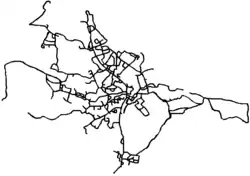Bus transport in Gdańsk
| Bus transport in Gdańsk | |||
|---|---|---|---|
A Solaris Urbino 12 operated by the city's bus transport agency | |||
| Overview | |||
| Owner | Gdańskie Autobusy i Tramwaje | ||
| Area served | Gdańsk and adjacent areas | ||
| Transit type | Buses | ||
| Number of lines | 76 | ||
| Operation | |||
| Began operation | 1912 | ||
| Number of vehicles | 292 | ||
| Technical | |||
| System length | 1,106 km (687 mi) (2014) | ||
| |||
Buses have been present in the public transport network of the Polish city of Gdańsk since 1912. Today operated largely by Gdańskie Autobusy i Tramwaje, the city's bus network extends to several nearby areas and has a large fleet of vehicles.
Network information
Currently, the bus network of Gdańsk consists of 76 regular routes, as well as 13 night routes and 1 seasonal route.[1] Aside from Gdańsk, the city's buses also serve Sopot, Pruszcz Gdański, Gmina Pruszcz Gdański, Gmina Kolbudy, and Gmina Żukowo. As of 2014, the length of all lines totalled 1,106 km (687 mi).[2]
History
The first bus in Gdańsk (then known as Danzig), known as the "Auto Omnibus", began its service on 13 August 1912, between Danzig and Heubude. They became a stable component of the city's transport network after 1920, although their role was not significant, overshadowed by the city's trams and railways. Before Danzig became part of Poland, various private companies operated bus services, including Peters Autobus-Verkehr, Danziger Verkehrsgesellschaft mbH, and Danziger Elektrische Straßenbahn AG.[3]
In June 1945, after the new Polish government took charge of the city, some irregular lines were set up using Dodge trucks and Büssing buses to Sopot and Gdynia, as well as more distant districts of the city of Gdańsk proper.[4] The city's first post-war buses, Büssing D38s, were on the city's streets up to the late 1950s.[5] After 1960, following the delivery of new buses built by Jelcz, new lines to Olszynka, Przymorze, and Osowa were opened. By the start of the 1970s, 22 bus lines and 116 bus stops were found in the city.[4]
Beginning in the 1970s, the city's buses became more popular than its trams, which was accompanied by the construction of a new bus depot in 1978. In 1994, the first low-floor bus in Poland was introduced in Gdańsk, followed by the first city bus in Poland with air conditioning in 1997.[6] In 2009, the last Ikarus buses were withdrawn from the fleet.[4]
In 2019, a private company, Welcome Airport Services, began operating the first electric buses in Gdańsk. They were apron buses operating at Lech Wałęsa Airport.[7] The first full electric city buses were rolled out in 2022,[8] and in 2023, several hydrogen buses were ordered at a cost of 172 million zł.[9] The buses were introduced to riders in 2024, although their purchase was controversial among the residents.[10]
Fleet
As of 2018, the city's fleet of buses consisted of the following vehicles:[11]
| Image | Name | Amount in fleet (2018) | Notes |
|---|---|---|---|
 |
Mercedes-Benz O405 | 34 | The first low-floor bus in Gdańsk, since retired[12] |
 |
Solaris Urbino 12 | 37 | |
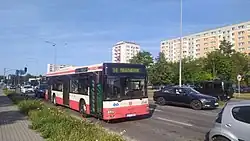 |
MAN NL 263 and 283 | 24 | |
| Neoplan N4007 | 3 | Since retired[13] | |
| MAN 469 NM222 | 2 | Since retired[14] | |
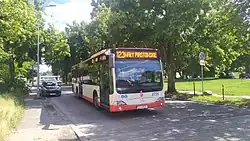 |
Mercedes-Benz Citaro | 15 | |
 |
MAN NG313 | 3 | |
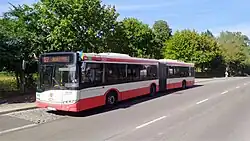 |
Solaris Urbino 18 | 44 | |
 |
Mercedes-Benz Conecto | 22 | |
 |
Iveco 65C Urby | 6 |
Vehicles acquired since 2018
Since 2018, the city has acquired the following vehicles:[15][16]
| Image | Name | Amount in fleet | Introduction | Notes |
|---|---|---|---|---|
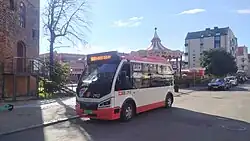 |
Karsan e-Jest | 3 | 2022 | Operates only on one route |
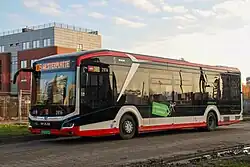 |
MAN NL326 Lion's City 12 E | 10 | 2023 | |
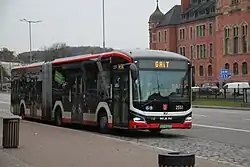 |
MAN NG544 Lion's City 18 E | 8 | 2023 |
References
- ^ "Autobusy". ztm.gda.pl. Zakład Transportu Miejskiego. Retrieved 19 July 2025.
- ^ Uchwalenia „Planu zrównoważonego rozwoju publicznego transportu zbiorowego dla Miasta Gdańska na lata 2014-2030” (city law). Gdańsk City Council. 27 February 2014. Retrieved 19 July 2025.
- ^ Gliński, Mirosław. "AUTOBUSY MIEJSKIE". gedanopedia.pl. Retrieved 19 July 2025.
- ^ a b c Kosycarz, Maciej (2015). Gdańsk w tramwajach i autobusach. Gdańsk: Kosycarz Foto Press KFP. ISBN 978-83-937367-6-8.
- ^ Borowski, Rafał (27 June 2015). "70 lat temu uruchomiono powojenną komunikację w Gdańsku". trojmiasto.pl. Retrieved 19 July 2025.
- ^ Libuda, Bartosz. "Gdańskie autobusy" (PDF). Herold Gdański. Vol. XVII, no. 6. Retrieved 19 July 2025.
- ^ Dobiegała, Anna (27 May 2019). "Na gdańskim lotnisku mamy pierwszy elektryczny autobus". wyborcza.pl. Gazeta Wyborcza. Retrieved 19 July 2025.
- ^ Stąporek, Michał (1 June 2022). "Elektryczne autobusy same policzą swoich pasażerów". trojmiasto.pl. Retrieved 19 July 2025.
- ^ Korolczuk, Maciej (12 September 2023). "Autobusy wodorowe w Gdańsku. Niemal 172 mln za 10-letni kontrakt". trojmiasto.pl. Retrieved 19 July 2025.
- ^ Korolczuk, Maciej (23 October 2024). "Jak radzą sobie gdańskie autobusy wodorowe? Sprawdziliśmy". trojmiasto.pl. Retrieved 19 July 2025.
- ^ "Analiza kosztów i korzyści związanych z wykorzystaniem przy świadczeniu usług komunikacji miejskiej autobusów zeroemisyjnych" (PDF). cloudgdansk.pl. 2018. Retrieved 19 July 2025.
- ^ "Mercedes-Benz O405N". gait.pl. Retrieved 19 July 2025.
- ^ Woźniak, Karol (12 May 2019). "Neoplan N4007 #2480". phototrans.pl. Retrieved 19 July 2025.
- ^ "MAN 469 NM222". gait.pl. Retrieved 19 July 2025.
- ^ Koprowski, Krzysztof (24 March 2025). "Tureckie autobusy elektryczne będą wozić gdańszczan. Rok na dostawę 30 pojazdów". trojmiasto.pl. Retrieved 19 July 2025.
- ^ Wojewski, Kamil (21 October 2023). "GDAŃSK: Osiemnaście fabrycznie nowych elektryków marki MAN już do spotkania na liniach". htp.org.pl. Retrieved 19 July 2025.
